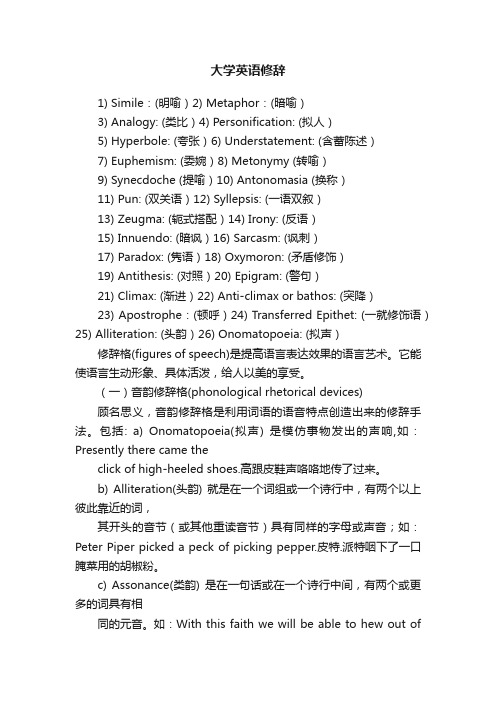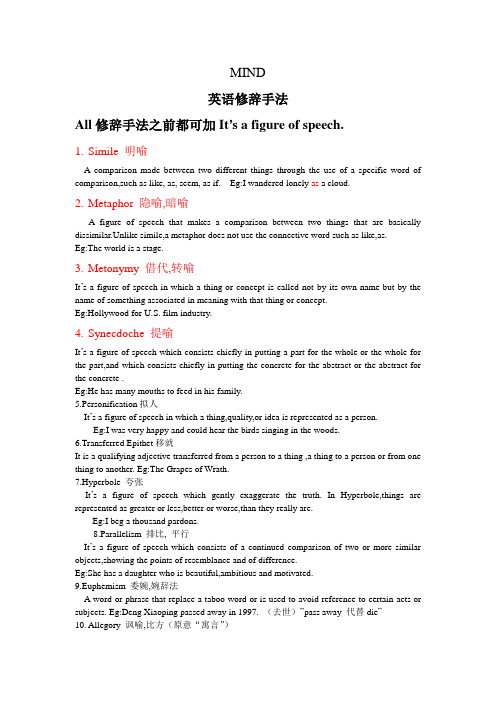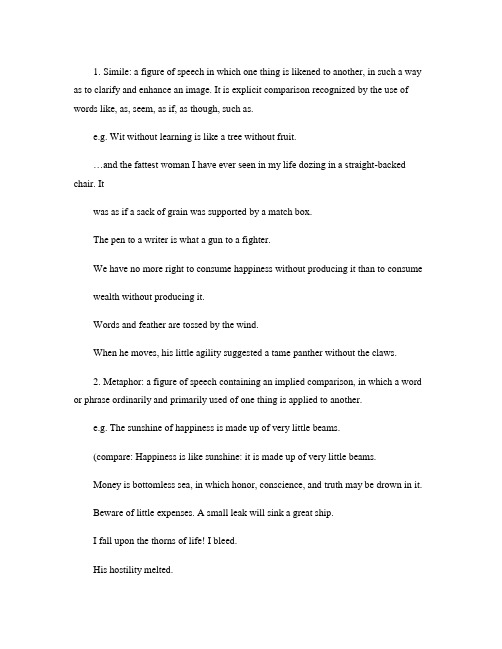现代大学英语6 修辞总结
- 格式:doc
- 大小:23.50 KB
- 文档页数:3

英语完整修辞手法英语常用修辞1.Simile 明喻明喻是将具有共性的不同事物作对比.这种共性存在于人们的心里,而不是事物的自然属性。
或者说是以两种具有相同特征的事物和现象进行对比,表明本体和喻体之间的相似关系,两者都在对比中出现。
标志词常用like, as, seem, as if, as though, similar to, such as等. It is a figure of speech which makes a comparison between two unlike elements having at least one quality or characteristic in common. To make the comparison, words like as, as...as, as if and like are used to transfer the quality we associate with one to the other.例如:1>.He was like a cock who thought the sun had risen to hear him crow.2>.I wandered lonely as c cloud.3>.Einstein only had a blanket on, as if he had just walked out of a fairy tale.4>.This elephant is like a snake as anybody can see.这头象和任何人见到的一样像一条蛇。
5>.He looked as if he had just stepped out of my book of fairytales and had passed me like a spirit.他看上去好像刚从我的童话故事书中走出来,像幽灵一样从我身旁走过去。

大学英语修辞1) Simile:(明喻)2) Metaphor:(暗喻)3) Analogy: (类比)4) Personification: (拟人)5) Hyperbole: (夸张)6) Understatement: (含蓄陈述)7) Euphemism: (委婉)8) Metonymy (转喻)9) Synecdoche (提喻)10) Antonomasia (换称)11) Pun: (双关语)12) Syllepsis: (一语双叙)13) Zeugma: (轭式搭配)14) Irony: (反语)15) Innuendo: (暗讽)16) Sarcasm: (讽刺)17) Paradox: (隽语)18) Oxymoron: (矛盾修饰)19) Antithesis: (对照)20) Epigram: (警句)21) Climax: (渐进)22) Anti-climax or bathos: (突降)23) Apostrophe:(顿呼)24) Transferred Epithet: (一就修饰语)25) Alliteration: (头韵)26) Onomatopoeia: (拟声)修辞格(figures of speech)是提高语言表达效果的语言艺术。
它能使语言生动形象、具体活泼,给人以美的享受。
(一)音韵修辞格(phonological rhetorical devices)顾名思义,音韵修辞格是利用词语的语音特点创造出来的修辞手法。
包括: a) Onomatopoeia(拟声) 是模仿事物发出的声响,如:Presently there came theclick of high-heeled shoes.高跟皮鞋声咯咯地传了过来。
b) Alliteration(头韵) 就是在一个词组或一个诗行中,有两个以上彼此靠近的词,其开头的音节(或其他重读音节)具有同样的字母或声音;如:Peter Piper picked a peck of picking pepper.皮特.派特咽下了一口腌菜用的胡椒粉。

MIND英语修辞手法All修辞手法之前都可加It’s a figure of speech.1.Simile 明喻A comparison made between two different things through the use of a specific word of comparison,such as like, as, seem, as if. Eg:I wandered lonely as a cloud.2.Metaphor 隐喻,暗喻A figure of speech that makes a comparison between two things that are basically dissimilar.Unlike simile,a metaphor does not use the connective word such as like,as.Eg:The world is a stage.3.Metonymy 借代,转喻It’s a figure of speech in which a thing or concept is called not by its own name but by the name of something associated in meaning with that thing or concept.Eg:Hollywood for U.S. film industry.4.Synecdoche 提喻It’s a figure of speech which consists chiefly in putting a part for the whole or the whole for the part,and which consists chiefly in putting the concrete for the abstract or the abstract for the concrete .Eg:He has many mouths to feed in his family.5.Personification拟人It’s a figure of speech in which a thing,quality,or idea is represented as a person.Eg:I was very happy and could hear the birds singing in the woods.6.Transferred Epithet移就It is a qualifying adjective transferred from a person to a thing ,a thing to a person or from one thing to another. Eg:The Grapes of Wrath.7.Hyperbole 夸张It’s a figure of speech which gently exaggerate the truth. In Hyperbole,things are represented as greater or less,better or worse,than they really are.Eg:I beg a thousand pardons.8.Parallelism 排比, 平行It’s a figure of speech which consists of a continued comparison of two or more similar objects,showing the points of resemblance and of difference.Eg:She has a daughter who is beautiful,ambitious and motivated.9.Euphemism 委婉,婉辞法A word or phrase that replace a taboo word or is used to avoid reference to certain acts or subjects. Eg:Deng Xiaoping passed away in 1997. (去世)”pass away 代替die”10.Allegory 讽喻,比方(原意“寓言”)2>.It's time to turn plough into sword.表层含义:是时候把犁变成剑11.Irony 反语It’s a figure of speech in which the words of the speaker or writer seems to mean one thing,but in reality mean just the contrary.Eg:It would be a fine thing indeed not knowing what time it was in the morning.早上没有时间观念还真是一件好事啊(真实含义是应该明确早上的时间观念)12.Pun 双关1>.She is too low for a high praise, too brown for a fair praise and too little for a great praise.2>.An ambassador is an honest man who lies abroad for the good of his country.3>.If we don't hang together, we shall hang separately.13.Parody 仿拟例如:1>.Rome was not built in a day, nor in a year.2>.A friend in need is a friend to be avoided.3>.If you give a girl an inch nowadays she will make address of it.14.Rhetorical question 修辞疑问(反问)它与疑问句的不同在于它并不以得到答复为目的,而是以疑问为手段,取得修辞上的效果,其特点是:肯定问句表示强烈否定,而否定问句表示强烈的肯定.它的答案往往是不言而喻的.例如:1>.How was it possible to walk for an hour through the woods and see nothing worth of note?2>.Shall we allow those untruths to go unanswered?15.Antithesis 对照,对比,对偶这种修辞指将意义完全相反的语句排在一起对比的一种修辞方法.例如:1>.Not that I loved Caeser less but that I loved Romemore.2>.You are staying; I am going.3>.Give me liberty, or give me death.16.Paradox 隽语这是一种貌似矛盾,但包含一定哲理的意味深长的说法,是一种矛盾修辞法..例如:1>.More haste, less speed.欲速则不达2>.The child is the father to the man.(童年时代可决定人之未来)三岁看大,四岁看老。

1. Simile: a figure of speech in which one thing is likened to another, in such a way as to clarify and enhance an image. It is explicit comparison recognized by the use of words like, as, seem, as if, as though, such as.e.g. Wit without learning is like a tree without fruit.…and the fattest woman I have ever seen in my life dozing in a straight-backed chair. Itwas as if a sack of grain was supported by a match box.The pen to a writer is what a gun to a fighter.We have no more right to consume happiness without producing it than to consumewealth without producing it.Words and feather are tossed by the wind.When he moves, his little agility suggested a tame panther without the claws.2. Metaphor: a figure of speech containing an implied comparison, in which a word or phrase ordinarily and primarily used of one thing is applied to another.e.g. The sunshine of happiness is made up of very little beams.(compare: Happiness is like sunshine: it is made up of very little beams.Money is bottomless sea, in which honor, conscience, and truth may be drown in it.Beware of little expenses. A small leak will sink a great ship.I fall upon the thorns of life! I bleed.His hostility melted.By this time the volcanic fires of his nature had burnt down.3. parallelism: comes from Greek, it means to be alongside one another. It put the words, phrases, clauses and sentences similar or close in meaning, or structure alongside one another.e.g. with this faith we will be able to work together, to pray together, to struggle together, togo to jail together…It was not anger, nor surprise, nor disapproval, nor horror, nor any of the emotions that she had been prepared for.4. Antithesis: the rhetorical opposing or contrasting of ideas by means of grammatically paralleled arrangement of words, clauses or sentences.e.g. when poverty comes in at the door, love flies out at the window.Men make houses, women make home.We found ourselves rich in goods, but ragged in spirit.As for me: give me liberty or give me death.5. allusion(典故,隐喻,: usually an implicit reference, perhaps to another work of literature or art, to a person or an event.e.g. Y our want your pound of flesh?I never believe until then that any meal could defeat me, but on that day I met mywaterloo.6. Anaphora: the rhetorical device of repeating a word or phrase at the beginning of successive clauses or sentences.eg. Let us be dissatisfied until America…Let us dissatisfied until slums…Let us be dissatisfied until integration…7. Chiasmus(交错配列词: a reversal in the order of words in two otherwise parallel phraseseg. A well-educated man should know something of everything and everything of something.An optimist sees an opportunity in every calamity; a pessimist sees a calamity in everyopportunity.Love makes time pass, time makes love pass.8. Paradox is a statement that appears to be logically contradictory and yet may be true, the purpose of which is to provoke fresh thought.e.g. More haste, less speed.The Child is father of the Man9. Alliteration: 头韵occurrence of the same letter or sound at the beginning of two or more words in successioneg. A misty morning may have a fine day.He remained loyal to me through thick and thin.He is as proud as a peacock.10. Transferred epithet : 修饰转换\移位修饰the transference of an adjective to a noun to which it is not wholly appropriateeg. There was a short, thoughtful silence.This is the cheapest market in this country.He closed his busy life at the age of sixty.11. Understatement: Understatement is used when a speaker wants to a make a situation seem less strong or important than it is. It is often, but not always, expressed by the negation of the opposite.eg. London is not the cheapest place in the world. (London is expensiveHe's a little on the old side. (Her new husband is oldI wouldn't say it tasted great. (The food is terrible12. Hyperbole: deliberate and obvious exaggeration used for effect.eg. Her wrinkles weigh more than she does! (she is very oldMy history teacher's so old, he lived through everything we've learned about ancientGreeceI think of you a million times a day.13. Metonymy: (转喻the kind of figure of speech in which the name of one thing is used in place of that of another associated with or suggested by it.e.g. He is too fond of the bottle.The crown presided the new year party in the palace.14. Synecdoche: (提喻 in which a term is used in one of the following ways:∙Part of something is used to refer to the whole thing or∙A thing (a "whole" is used to refer to part of it or∙A specific class of thing is used to refer to a larger, more general class, or∙A general class of thing is used to refer to a smaller, more specific class, or∙A material is used to refer to an object composed of that material, or∙A container is used to refer to its contents.Eg. He earns his bread by writing.Australia beat Canada at cricket.He is the Newton of this century.He was hurt and he needed Band-Aid. (for any variety of adhesive bandageShe was dressed in silks.Ps: 最后两种修辞比较容易混淆, synecdoche重点“部分代整体\整体代部分\材料代成品”。

英语修辞手法1.Simile明喻明喻是将具有共性的不同事物作对比.这种共性存在于人们的心里,而不是事物的自然属性.标志词常用like,as,seem,asif,asthough,similarto,suchas等.例如:1>.Hewaslikeacockwhothoughtthesunhadrisentohearhimcrow.2>.Iwanderedlonelyasacloud.3>.Einsteinonlyhadablanketon,asifhehadjustwalkedoutofafairytale.2.Metaphor隐喻,暗喻隐喻是简缩了的明喻,是将某一事物的名称用于另一事物,通过比较形成.例如:1>.Hopeisagoodbreakfast,butitisabadsupper.2>.Somebooksaretobetasted,othersswallowed,andsomefewtobechewedanddigested.3.Metonymy借喻,转喻借喻不直接说出所要说的事物,而使用另一个与之相关的事物名称.I.以容器代替内容,例如:1>.Thekettleboils.水开了.2>.Theroomsatsilent.全屋人安静地坐着.II.以资料.工具代替事物的名称,例如:Lendmeyourears,please.请听我说.III.以作者代替作品,例如:acompleteShakespeare莎士比亚全集VI.以具体事物代替抽象概念,例如:Ihadthemuscle,andtheymademoneyoutofit.我有力气,他们就用我的力气赚钱.4.Synecdoche提喻提喻用部分代替全体,或用全体代替部分,或特殊代替一般.例如:1>.Thereareabout100handsworkinginhisfactory.(部分代整体)他的厂里约有100名工人.2>.HeistheNewtonofthiscentury.(特殊代一般)他是本世纪的牛顿.3>.Thefoxgoesverywellwithyourcap.(整体代部分)这狐皮围脖与你的帽子很相配.?5.Synaesthesia通感,联觉,移觉这种修辞法是以视.听.触.嗅.味等感觉直接描写事物.通感就是把不同感官的感觉沟通起来,借联想引起感觉转移,“以感觉写感觉”。

Rhetorical Devices一、明喻(simile )是以两种具有相同特征的事物和现象进行对比,表明本体和喻体之间的相似关系,两者都在对比中出现。
常用比喻词like, as, as if, as though等,例如:1、This elephant is like a snake as anybody can see.这头象和任何人见到的一样像一条蛇。
2、He looked as if he had just stepped out of my book of fairytales and had passed me like a spirit.他看上去好像刚从我的童话故事书中走出来,像幽灵一样从我身旁走过去。
3、It has long leaves that sway in the wi nd like slim fin gers reach ing to touch someth ing.它那长长的叶子在风中摆动,好像伸出纤细的手指去触摸什么东西似的。
二、隐喻(metaphor )这种比喻不通过比喻词进行,而是直接将用事物当作乙事物来描写,甲乙两事物之间的联系和相似之处是暗含的。
1、German guns and German planes rained down bombs, shells and bullets... 德国人的枪炮和飞机将炸弹、炮弹和子弹像暴雨一样倾泻下来。
2、The diamond department was the heart and center of the store.钻石部是商店的心脏和核心。
三、Allusi on (暗引)其特点是不注明来源和出处,一般多引用人们熟知的关键词或词组,将其融合编织在作者的话语中。
引用的东西包括典故、谚语、成语、格言和俗语等。
英语引用最多的是源出《圣经》故事以及希腊、罗马神话、《伊索寓言》和那些源远流长的谚语、格言等。
例如:1、Grammar may be his heel of Achilles.语法是他的大弱点。
thesadyoungman修辞总结前言在探索文学艺术的道路上,修辞是一把锋利的武器。
优秀的创作者懂得如何巧妙地运用各种修辞手法来赋予作品更丰富的表现力和感染力。
因此,对于修辞手法的总结和学习对于我们每个创作者来说都至关重要。
本文将对“thesadyoungman修辞总结”进行深入剖析,希望能给大家带来一些启发和灵感。
正文1.修辞手法的定义和作用•修辞手法是指作者在表达思想、情感和意境时所采用的一些特定的表达方式,通过运用形象化、夸张、比喻等手法,增强作品的吸引力和感染力。
•修辞手法可以让文字更富有表现力和感染力,使读者更易于理解作者的意图,并深入到作品的内心世界。
2.常见的修辞手法及特点比喻•比喻是通过将两个不同的事物进行比较,以达到表达更深层次含义的修辞手法。
•通过比喻,作者可以用一个具体的形象来代替抽象的概念或感受,从而让读者更加直观地理解作者的观点和情感。
拟人•拟人是给非生命事物或抽象概念赋予人的形象和行为特征的修辞手法。
•通过拟人手法,作者可以让事物或概念更具有情感色彩,让读者更容易与之产生共鸣。
借代•借代是用一种普通的词语来代替一个专业术语或高级词语,从而达到减少歧义、增加表达效果的修辞手法。
•通过借代,作者可以使作品更加通俗易懂,让读者更容易理解。
排比•排比是通过列举一系列相同结构的词语或句子,以增加修辞效果、增强表达力的修辞手法。
•通过排比,作者可以使作品更富有节奏感和韵律感,让读者更容易被吸引。
3.修辞在创作中的应用技巧•修辞手法作为一种手段,需要在恰当的时候使用,不能过多也不能过硬。
•修辞手法需要与作品的主题和氛围相契合,选择合适的修辞手法可以让作品更加生动有趣或响亮有力。
结尾修辞手法是一种让作品更富有表现力和感染力的利器。
通过比喻、拟人、借代和排比等修辞手法的运用,作品能够更深入人心,给读者带来更大的享受和思考。
作为资深的创作者,我们需要不断地学习和探索修辞的奥秘,提升自己的文学素养和创作水平。
大学英语修辞格大学英语常见修辞格所谓修辞是指依据题旨情境恰当地选择语言手段和表达方式, 以有效地表情达意。
修辞的目的是使作品更加形象生动、引人入胜。
了解英语中的修辞, 有助于我们更好地理解、欣赏文章,也有助于在写作中丰富我们自己的表达。
英语修辞格按其构成大致可以分为三类:(一)词义修辞格(Lexical Rhetorical Devices)词义修辞格主要是指借助语义的联想和语言的变化等特点创造出来的修辞手法。
大学英语中常见的词义修辞格有以下几种:1. Simile 明喻与汉语的明喻基本相同,是以两种具有相同特征的事物和现象进行对比,表明本体和喻体之间的相似关系。
常用来表示明喻的喻词有like, as, as if, as though等。
如:Learning is like rowing upstream; not to advance is to drop back. 学如逆水行舟,不进则退。
2. Metaphor 暗喻暗喻也是一种比喻, 但不用比喻词, 因此被称为"缩减了的明喻(a compressed simile)"。
它是根据两个事物间的某些共同的特征, 用一事物去暗示另一事物的比喻方式。
如:And yet, while most of us are only too ready to apply to others the cold wind of criticism, we are somehow reluctant to give our fellows the warm sunshine of praise. 但是,尽管我们中的很多人太容易给别人批评的冷风,却不知何故不愿意给我们的同伴赞扬的阳光。
(该句中,将criticism比喻成cold wind,将praise比喻成warm sunshine,但是未使用任何比喻词,因此为暗喻。
)3. Metonymy转喻/借代转喻类似于汉语中的借代修辞,是通过相近的联想, 借喻体代替本体,它根本不说出本体事物, 直接用比喻事物代替本体事物。
常见的英语修辞方式人们在说话或写文章时,总希望别人爱听或爱读,于是常常使用修辞的手段。
修辞是有效地运用语言,使其能更好地表达思想感情的一种艺术,在英语文章中,尤其是在文学作品中经常出现:修辞也是“阅读与写作”考试中的一项考试内容。
下面介绍几种常见的英语修辞方式。
1. Simile 明喻.【英释】Simile refers to a direct comparison between two or more things, normally introduced by like or as.【汉释】把具有某种共同特征的两种不同事物进行比较,用一种事物比喻所要说明的另一种事物,这种对比在修辞学上叫做明喻。
两种事物间的共同点是想象出来的,而不是事物本身所具有的,常用的比喻词有as(如),like(像),seem(似乎),as if(好像),as through(好像),such as(像……一样)等。
其基本格式是“A is like B”或“A is as……as B”。
【例句】He has been as drunk as a fiddler’s bitch.⑴他醉得像小提琴手的母狗。
⑵他曾喝得酊名大醉/烂醉如泥。
If we haven’t got any money, we can’t buy a television. It’s as plain as the nose on your face.⑴如果我们没有钱,就不能买电视机。
这就像脸上的鼻子一样清楚明了。
⑵没有钱我们就不能买电视机。
这就像秃子头上的虱子——明摆着的事。
Mr. Smith may serve as a good secretary, for he is as close as an oyster.⑴史密斯先生可以当个好秘书,因为他嘴巴紧得像牦蛎.⑵史密斯先生可以当个好秘书,因为他守口如瓶。
2. Metaphor 暗喻,隐喻.【英释】Metaphor is an implied comparison between two or more things achieved by identifying one with the other.【汉释】暗喻是本体和喻体同时出现,它们之间在形式上是相合的关系,说甲(本体)是(喻词)乙(喻体)。
高英II 修辞总结 Unit 1 : 1. Satire: 1) This is associated with the names of David Ricardo, a stockbroker, and Thomas Robert Maltus, a divine. 2) Murray is the voice of Spencer our time; he is enjoying, as indicated, unparalleled popularity in high Washington circles. 2. Irony: 1) This is, in some ways, an admirable solution. 2) Couples in love should repair to R.H. Macy’s, not their bedrooms 3) ```Social Darwinism came to be considered a bit too cruel. 4) It has again become a major philosophical, literary, and rhetorical preoccupation, and an economically not unrewarding enterprise. 5) In the enduring words of Professor Milton Friedman, people must be “free to choose”. 6) All, save perhaps the last, are great inventive descent form Bentham, Malthus, and Spencer. 3. Critical attitude: The only form of discrimination that is still permissinle```is discrimination against people who work for the federal government, especially on social welfare activities.
Unit 2: 1. Simile: 1) Its underwater grasses looked like green ribbons constantly unrolling, and the trees held thick sprays of wild orchids. 2) The burly arms of the oaks were huge with ferns and blooming bromeliads. 3) The native whites feared him as you would a rattlesnake, but``` 2. Foreshadowing: I heard that countless human skeletons were left bare in his bayou once when a hurricane blew the water out. 3. Suggestion: He had secluded himself in this remote area of the Everglades because he was not welcome elsewhere; from time to time he was halfheartedly sought for trial,``` 4. Understatement: There was the little shack, not the most gracious of living quarters, and there was a murderer for our nearest and only neighbor, about thirty miles away. 5. Quotation :(a legend): But these marks o wild country called to my father like the legendary siren song. 6. Comparison: 1) King Richard in his gluttony never sat at a table more sumptuous than ours was three times a day. 2) With the weight of this new stillness on it, this seal. Unit 3: 1. Allusion: Like Creation, the portending global events are cosmic: They change the relationship between the planet Earth and its star, the sun. 2. Metaphor: 1) It is not so much a battle cry for one side or the other, as a design for negotiating and end to suicidal war—for making peace with the planet. 2) How all my town territory would be altered, as if a landslide had gone through it and skimmed off all meaning except loss of Mike. 3. Pun: But unlike the conventional marketplace, which deals in goods—things that serve a useful purpose—this scheme creates a marketplace in “bads”—things that are not only useless but often deadly. Unit 4: 1. Personification: Each of the trees on the place had an attitude and a presence—the elm looked serene and the oak threatening, the maples friendly, the hawthorn old and crabby.
3. Alliteration: She did not ask me—was it delicacy or disapproval? 4. (通感): 1) All afternoon while the men were gone I was full of happy energy. (happy 实际上是用来修饰“我”) 4. Parallel structure: Against the belief in the all-encompassing power of single explanation, against```, against```(unit 5)
Unit 6: 1. Pseudo-serious tone: The creams, slightly muffled by oil,```as though torture were being carried out but they didn’t last long: It was all over rather suddenly, and, his legs released, the pig righted himself. 2. Biblical allusion: 1) From then until the time of his death I held the pig steadily in the bowl of my mind; 2) The pig’s lot and mine inextricably bound now, as though the rubber tube were the silver cord. 3. Alliteration: But even so, there was a directness and dispatch about animal burial. 4. Symbolize: He had evidently become precious to me, not that he represented a distant nourishment in a hungry time, but that he had suffered in a suffering world. (对作者来说,the suffering of the pig symbolizes the suffering of human beings.)
5. Humorous: 1) The frequency of our trips down the footpath through the orchard to the pig yard delighted him, although he suffers greatly arthritis, moves with difficulty, and would be bedridden if he could find anyone willing to serve him meals on the tray. 2) I have come to believe that there is in hostesses a special power of divination, and that they deliberately arrange dinners to coincide with pig failure or some other sort of failure.(humorously accuses the hostesses ) 3) This was slapstick—the sort of dramatic treatment that instantly appealed to my old dachund, Fre,```presided at the interment. 4) This uncertainty afflicts me with a sense of personal determination; if I were in decent health I would know how many nights I had sat up with a pig. 6. Parallel structure: 1) ```with the fog shutting in every night, scaling for a few hours in mid-day, then creeping back again at dark, drifting in first over the trees on the point, then``` 2) ```everything about the last scene seemed overwritten—the dismal sky, the shabby woods, the imminence of rain, the worm``